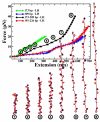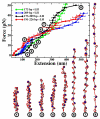Forced unraveling of chromatin fibers with nonuniform linker DNA lengths
- PMID: 25564319
- PMCID: PMC4554754
- DOI: 10.1088/0953-8984/27/6/064113
Forced unraveling of chromatin fibers with nonuniform linker DNA lengths
Abstract
The chromatin fiber undergoes significant structural changes during the cell's life cycle to modulate DNA accessibility. Detailed mechanisms of such structural transformations of chromatin fibers as affected by various internal and external conditions such as the ionic conditions of the medium, the linker DNA length, and the presence of linker histones, constitute an open challenge. Here we utilize Monte Carlo (MC) simulations of a coarse grained model of chromatin with nonuniform linker DNA lengths as found in vivo to help explain some aspects of this challenge. We investigate the unfolding mechanisms of chromatin fibers with alternating linker lengths of 26-62 bp and 44-79 bp using a series of end-to-end stretching trajectories with and without linker histones and compare results to uniform-linker-length fibers. We find that linker histones increase overall resistance of nonuniform fibers and lead to fiber unfolding with superbeads-on-a-string cluster transitions. Chromatin fibers with nonuniform linker DNA lengths display a more complex, multi-step yet smoother process of unfolding compared to their uniform counterparts, likely due to the existence of a more continuous range of nucleosome-nucleosome interactions. This finding echoes the theme that some heterogeneity in fiber component is biologically advantageous.
Figures






Similar articles
-
Chromatin fiber polymorphism triggered by variations of DNA linker lengths.Proc Natl Acad Sci U S A. 2014 Jun 3;111(22):8061-6. doi: 10.1073/pnas.1315872111. Epub 2014 May 20. Proc Natl Acad Sci U S A. 2014. PMID: 24847063 Free PMC article.
-
A critical role for linker DNA in higher-order folding of chromatin fibers.Nucleic Acids Res. 2021 Mar 18;49(5):2537-2551. doi: 10.1093/nar/gkab058. Nucleic Acids Res. 2021. PMID: 33589918 Free PMC article.
-
Modeling studies of chromatin fiber structure as a function of DNA linker length.J Mol Biol. 2010 Nov 12;403(5):777-802. doi: 10.1016/j.jmb.2010.07.057. Epub 2010 Aug 13. J Mol Biol. 2010. PMID: 20709077 Free PMC article.
-
Chromatosome Structure and Dynamics from Molecular Simulations.Annu Rev Phys Chem. 2020 Apr 20;71:101-119. doi: 10.1146/annurev-physchem-071119-040043. Epub 2020 Feb 4. Annu Rev Phys Chem. 2020. PMID: 32017651 Review.
-
Emerging roles of linker histones in regulating chromatin structure and function.Nat Rev Mol Cell Biol. 2018 Mar;19(3):192-206. doi: 10.1038/nrm.2017.94. Epub 2017 Oct 11. Nat Rev Mol Cell Biol. 2018. PMID: 29018282 Free PMC article. Review.
Cited by
-
Determining mesoscale chromatin structure parameters from spatially correlated cleavage data using a coarse-grained oligonucleosome model.bioRxiv [Preprint]. 2024 Jul 29:2024.07.28.605011. doi: 10.1101/2024.07.28.605011. bioRxiv. 2024. PMID: 39131347 Free PMC article. Preprint.
-
Nucleosome Clutches are Regulated by Chromatin Internal Parameters.J Mol Biol. 2021 Mar 19;433(6):166701. doi: 10.1016/j.jmb.2020.11.001. Epub 2020 Nov 9. J Mol Biol. 2021. PMID: 33181171 Free PMC article.
-
The chromatin fiber: multiscale problems and approaches.Curr Opin Struct Biol. 2015 Apr;31:124-39. doi: 10.1016/j.sbi.2015.04.002. Epub 2015 Jun 5. Curr Opin Struct Biol. 2015. PMID: 26057099 Free PMC article. Review.
-
Kilobase Pair Chromatin Fiber Contacts Promoted by Living-System-Like DNA Linker Length Distributions and Nucleosome Depletion.J Phys Chem B. 2017 Apr 20;121(15):3882-3894. doi: 10.1021/acs.jpcb.7b00998. Epub 2017 Mar 31. J Phys Chem B. 2017. PMID: 28299939 Free PMC article.
-
Linking Chromatin Fibers to Gene Folding by Hierarchical Looping.Biophys J. 2017 Feb 7;112(3):434-445. doi: 10.1016/j.bpj.2017.01.003. Epub 2017 Jan 31. Biophys J. 2017. PMID: 28153411 Free PMC article. Review.
References
-
- Maeshima K, Hihara S, Eltsov M. Curr. Opin. Cell. Biol. 2010;22:291. - PubMed
Publication types
MeSH terms
Substances
Grants and funding
LinkOut - more resources
Full Text Sources
Other Literature Sources
